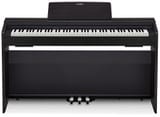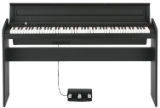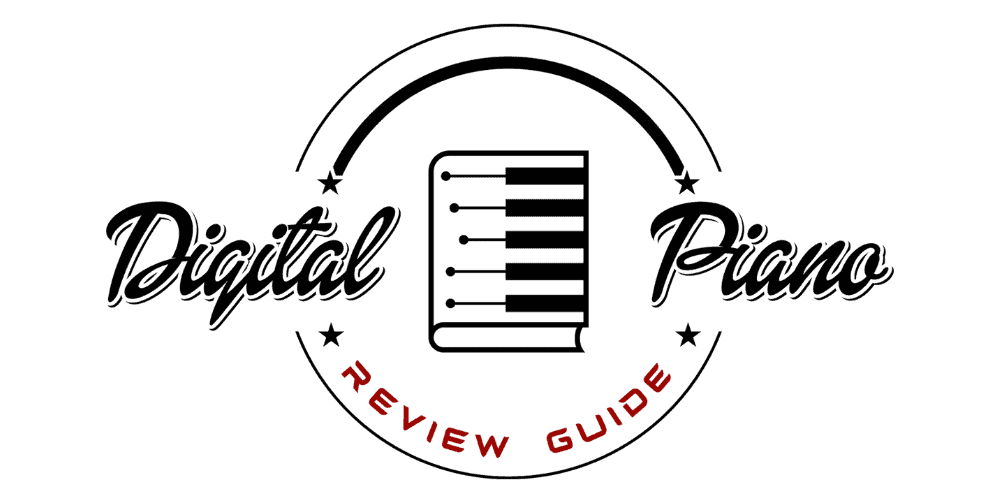Artesia PA-88W review: Good Digital Piano for Beginners?

The Artesia PA-88W is a cheap digital piano that is aimed at beginner pianists. At roughly $279.99, this digital piano is an extremely affordable first instrument.
But is it the right piano for you?
Well, in this article, we’ll examine this piano and help you determine if this is the best digital piano for beginners that money can buy. And, to better help you, please use the interactive guide below, which will let you directly compare the Artesia PA-88W to other notable digital pianos on the market.
| Photo | Model |
|---|---|
| Casio PX-S1100 | |
| Alesis Prestige Artist | |
| Casio CDP-S360 | |
| Yamaha P-515 | |
 | Casio PX-870 |
 | Korg LP-180 |
 | Casio PX-770 |
What the Artesia PA-88W Offers
The Artesia PA-88W has a Weighted Spring Action keyboard, which Artesia says is heavier than a synth action keyboard but lighter than a hammer action keyboard. Although this keyboard is not an incredibly accurate representation of an acoustic piano’s hammer action keyboard, this digital piano will be great for those who like playing with a lighter touch or who have never played an acoustic piano before.
For those who are coming to this instrument from an acoustic piano or a digital piano with a hammer action keyboard, the key action might take some getting used to.
This digital piano includes twelve instrument voices, and the standout amongst these voices is the Grand Piano sound. This voice is created by a triple-layered sample and sounds much more authentic and rich than is typically expected at such a low price point. The Artesia PA-88W also includes reverb and chorus effects, which help players to customize the sound of the instrument as they perform.
The Artesia PA-88W has 32-note polyphony. This amount of polyphony will not appeal to more experienced and advanced players, but it is enough polyphony for beginners.
Players will not be able to play intricate chords or have all of the notes sound in a lengthy glissando on this digital piano, but beginners and intermediate players will have plenty of polyphony to support their playing.
This digital piano includes 12 demo songs that pianists can play along with. The inclusion of these songs makes it easy for new players to learn some of their favorite songs at the start of their piano-playing journey.
The Artesia PA-88W comes with a sustain pedal and a music stand.

Below, please check out some of the best-selling digital pianos online, and see how well they stack up to the Artesia PA-88W.
| BEST SELLERS |
|---|
| 1) Yamaha P-515 |
| 2) Casio PX-S3100 |
| 3) Casio PX-870 |
| 4) Roland FP-E50 |
| 5) Roland FP-30X |
Good Keyboard for Beginners?
This digital piano is undeniably a great first keyboard for beginner players or for parents who don’t want to spend too much money on an instrument that they are not sure their child will stick with.
Beginners will certainly be happy with their purchase and can look forward to spending countless hours playing their digital piano. Those who stick with their piano practice and progress quickly, however, might soon find themselves longing for more.
With its very limited amount of polyphony, the Artesia PA-88W will leave players who move on to the intermediate and advanced levels wanting more. As pianists start to experiment with complicated chords and other advanced piano-playing techniques, they may find that this digital piano no longer fits their needs.
Still, the Artesia PA-88W will be perfectly adequate for the recreational player who simply wants to practice on occasion and learn how to play some of their favorite songs.
The Weighted Spring Action keyboard might put off some players, too. Truthfully, no digital piano can completely replicate the feeling of an acoustic piano’s hammer action, but a digital piano that has a hammer action keyboard certainly comes closer than one that does not.
Players who are coming from a hammer action digital piano or an acoustic piano might find the key action on the Artesia PA-88W unsatisfactory. The shift from this digital piano’s Weighted Spring Action keyboard to a hammer action keyboard might take some getting used to for players who start to learn how to play the piano on the Artesia PA-88W as well.
Artesia PA-88W vs Artesia PA-88H
The Artesia PA-88H is pretty similar to the Artesia PA-88W. There is one major difference, however; the PA-88H has a hammer action keyboard. As such, the keys feel heavier on this digital piano and more closely mimic the key action of an acoustic piano, and players will not have much trouble transitioning from this keyboard to that of an acoustic piano or a pricier digital piano.
At roughly $400, the Artesia PA-88H is just a little over $100 more than the Artesia PA-88W. This digital piano features the same triple-layered Grand Piano sound, but it includes fifteen additional voices whereas the Artesia PA-88W includes eleven additional voices.
This digital piano has 64-note polyphony, which is double that of the Artesia PA-88W. As such, players have more freedom to experiment with advanced chords and playing techniques.
Like with the Artesia PA-88W, this affordable digital piano’s polyphony may eventually prove disappointing to those who own it. As players advance their piano-playing skills, they might find that the Artesia PA-88H cannot keep up with them.
The Artesia PA-88H includes 16 demo songs that players can play along with whereas the Artesia PA-88W includes 12. While the addition of four more songs might not seem like much, the Artesia PA-88H offers pianists another way to perfect their craft; this digital piano is compatible with music learning apps and software.
This compatibility makes it easy for piano players to move beyond playing along with the demo songs and the sheet music they may purchase.
The Artesia PA-88W or PA-88H: Which is Best?
Ultimately, it comes down to personal preference and your piano-playing goals. For those who want a smoother transition to playing an acoustic piano later down the line, the Artesia PA-88H’s hammer action keyboard will certainly have an advantage over the PA-88W’s Weighted Spring Action keyboard.
Both offer a fairly limited amount of voices, but the Grand Piano voice is what buyers of these digital pianos will likely spend most of their time playing. This voice is a pretty accurate recreation of an acoustic grand piano, and buyers of either digital piano have access to it.
The PA-88H’s 64-note polyphony gives it an edge over the PA-88W, which offers 32-note polyphony. Neither boasts an impressive amount of polyphony, but the PA-88H does give players a bit more room to grow. Either way, people who stick with their piano practice may find themselves wanting an instrument that offers more polyphony later down the line.
Although both of these Artesia digital pianos are sort of entry level instruments, owners of either of these can take pride in finding an affordable entry point into the world of piano playing. At roughly $279 and $400 respectively, it would prove difficult to find digital pianos of this quality at a cheaper price. Even if players eventually move on to an acoustic piano or a higher end digital piano, they will look back on their memories of playing their Artesia PA-88W or PA-88H with fondness.
Artesia PA-88W vs Yamaha P-45
The Yamaha P-45 is the cheapest Yamaha digital piano on the market and is a great introduction to the well-known brand. The P-45 is made with Yamaha’s GHS (Graded Hammer Standard), which means the keys are lighter in the high end and heavier in the low end like on an acoustic piano’s keyboard. The keyboard’s sensitivity can be adjusted to hard, medium, soft, and fixed to suit any pianist’s touch.
This digital piano’s 10 built-in voices were created with AWM (Advanced Wave Memory) sampling. This type of sampling uses digital technology to capture realistic instrument sounds. As such, players can expect to hear accurate renditions of the instruments that are included in the Yamaha P-45’s library.
Layer mode lets Yamaha P-45 owners play one voice on top of another, and duet mode lets them play along with someone else.
This digital piano has 64-note polyphony. Again, this amount of polyphony is low for advanced players, but it is perfectly adequate for beginner to intermediate players. As players advance, however, they may find that they outgrow the Yamaha P-45 just as they would the Artesia PA-88W and PA-88H.
The Yamaha P-45 has four types of reverb but offers no other effects. Still, with multiple reverbs, players can tinker with their sound until it fits their artistic vision.
This digital piano does not have recording capabilities, but it can be hooked up to a computer via a USB connection to record music.
The Yamaha P-45 also includes a music stand and sustain pedal.
At only about $499, the Yamaha P-45 is a steal. Yamaha is known for creating high quality instruments at all price points. The AWM sampling that this digital piano’s onboard voices are created with makes for really realistic instrument sounds, and Yamaha’s Graded Hammer Standard makes for a keyboard that feels more like that of an acoustic piano than the Artesia digital pianos mentioned in this article do.
Artesia PA-88W vs Alesis Recital Pro
The Alesis Recital Pro is another affordable digital piano for beginners. This digital piano has a weighted keyboard and its touch sensitivity can be set to soft, medium, hard, or off, which results in a fixed velocity.
The Alesis Recital Pro has 12 built-in voices, including organs, synths, and bass. Split mode allows players to assign one voice to the lower half of the keyboard and another voice to the upper half. Layer mode lets musicians put one sound over another, like a piano sound over strings.
This is the only digital piano of those listed here to offer split mode, which gives it an edge over the Artesia PA-88H, Artesia PA-88W, and the Yamaha P-45 in regard to artistic expression. Being able to assign a voice to each half of the keyboard may spark inspiration in a way that playing in one consistent voice cannot.
With 128-note polyphony, this digital piano can support the average player’s experimentation with intricate chords and the keyboard’s effects.This is twice the polyphony of the Yamaha P-45 and Artesia PA-88H and quadruple that of the Artesia PA-88W. As such, players can stick with this digital piano for quite a while as they progress in skill and ability.
The Alesis Recital Pro offers players more effects than any other keyboard listed here.
This digital pianos effects include:
- 4 Chorus types
- 4 Celeste types
- 8 Reverb types
- 5 EQ presets
- Modulation
The Alesis Recital Pro comes with a music rest, but it does not include a sustain pedal. Players can expect to need a sustain pedal pretty early on in their career, so those who ultimately end up buying this digital piano should plan to buy a pedal separately.
The Alesis Recital Pro makes it easy for new players to get started on their new instrument by including a 3-month subscription to Skoove Premium, an online piano lesson service. Skoove allows players to progress at their own pace and gives them an opportunity to learn to play their favorite classical songs or even today’s top hits; this service also has a team of experts available to offer one-on-one support to its users.
At $349, the Alesis Recital Pro is certainly an excellent, affordable digital piano that has a lot to offer people at all stages of their piano-playing journey.
If you enjoyed this article, please “like us” on Facebook!






